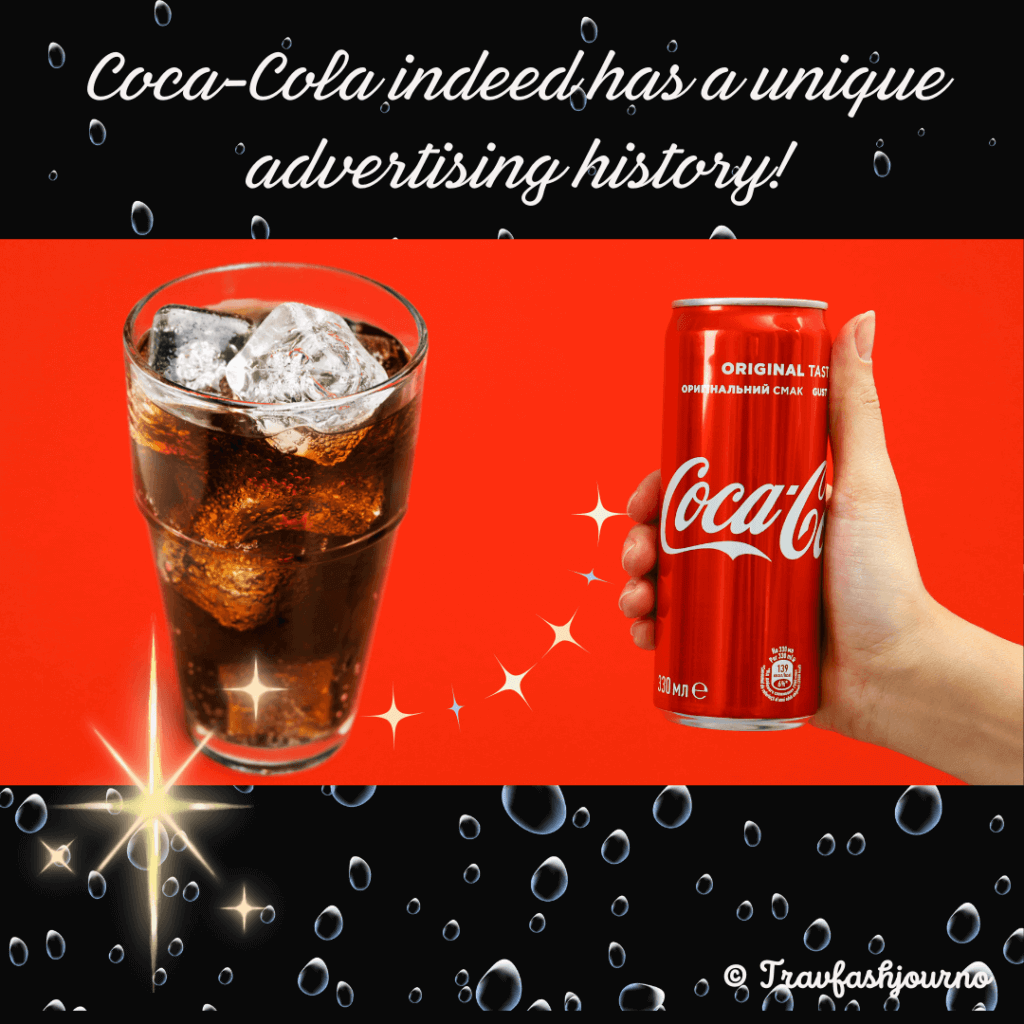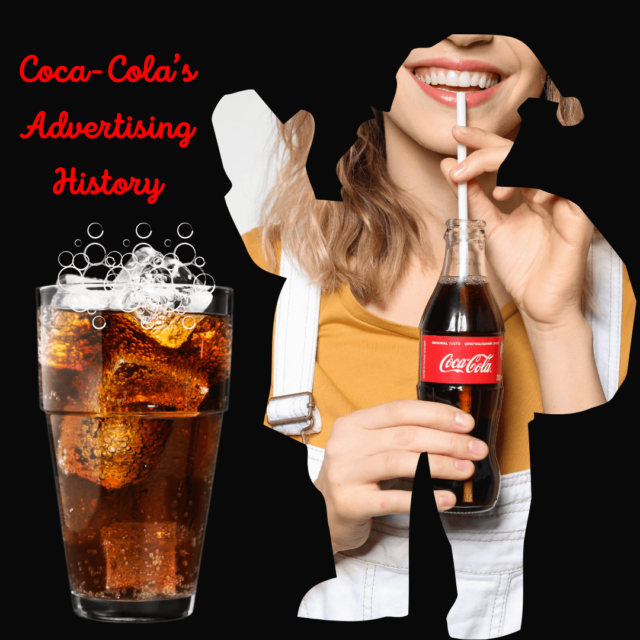Coca-cola Advertising History
The image of Santa Claus seems as permanent a fixture of Christmas as twinkling lights and frosted cookies. But did you know this jolly icon’s modern appearance might owe a surprising debt to the Coca-Cola Advertising History? Today, we delve into this fascinating connection, exploring how Coca-Cola’s ads not only shaped our modern Santa Claus, but also became a heartwarming tradition itself.
What is Creativity & Innovation Day? Read more about it. Maybe you can be inspired with ideas to boost your advertising and marketing campaigns!
Deep Diving into Coca-cola’s Advertising
The Humble Beginnings (1886):
- In 1886, Atlanta pharmacist Dr. John Pemberton concocted a syrup containing extracts of coca leaf (yes, coca!) and kola nut.
- He initially marketed it at Jacob’s Pharmacy as a temperance drink and “cure-all” for various ailments.
- Fun fact: Dr. Pemberton’s bookkeeper, Frank Robinson, gets credit for the iconic name “Coca-Cola” and the flowing script that’s still their trademark.
From Drugstore Fountain to Global Phenomenon (1888-1940s):
- Businessman Asa Griggs Candler acquired Coca-Cola in 1888 and with brilliant marketing strategies, propelled it to national and then international fame.
- Early advertising touted Coca-Cola’s supposed health benefits, but the focus soon shifted to refreshment.
- The 1915 contour bottle design, a unique and recognizable shape, was a major marketing win.
Post-War Expansion and Brand Evolution (1940s-Present):
- The post-war era saw Coca-Cola solidify its global presence.
- Partnerships like the iconic one with McDonald’s in 1955 further cemented its association with happy memories and togetherness.
- New products like Fanta and Sprite expanded their beverage portfolio.
- Coca-Cola has also navigated challenges, like the controversial “New Coke” formula change in the 1980s (which was later reversed due to public outcry).
Beyond the fizzy drink: A Beverage Giant (Present):
- Today, Coca-Cola is a beverage behemoth offering an array of products beyond the original cola.
- Sustainability efforts and social responsibility initiatives are a growing focus for the company.
Coca-Cola’s Marketing Strategies: A Recipe for Success (minus the secret formula)

Coca-Cola’s marketing strategies are legendary, playing a huge role in propelling the drink from a drugstore concoction to a global icon. Here’s a look at some key elements:
- Early Days: Building Brand Awareness (1886-1900s):
- Coupons for free drinks were a clever tactic to get people to try the new beverage.
- Eye-catching merchandise like calendars and soda fountain urns kept the brand in sight.
- Asa Candler’s aggressive marketing strategies involved sponsorships and strategically placed signage.
- The Power of Image and Storytelling (1900s-1940s):
- Coca-Cola ads shifted focus from supposed health benefits to refreshment and happiness.
- Santa Claus was depicted enjoying Coca-Cola in ads as early as the 1920s, helping shape the modern Santa Claus image [This claim about Santa Claus being shaped by Coca-Cola ads is a complex one, with some attributing the modern image more to Haddon Sundblom’s illustrations. You can explore this further in your blog].
- Early mascots like the effervescent “Sprite Boy” added a playful personality to the brand.
- Global Expansion and Evolving with the Times (1940s-Present):
- Coca-Cola’s marketing adapted to different cultures and languages for global appeal.
- Sponsorships of major sporting events like the Olympics further cemented the brand’s association with positive experiences.
- Television commercials became a powerful tool, with catchy jingles and heartwarming messages.
- Social media engagement and influencer marketing are key strategies today.
How about use Meta AI Chatbot Solutions on Whatsapp or Instagram to curate campaigns out of the ideas provided by the AI (think of it as your own little helper)?
Evolution of the Coca-Cola Recipe (minus the top-secret formula)
While the exact formula for Coca-Cola remains a closely guarded secret, here’s what we do know about the recipe’s evolution:
- The Original Elixir (1886): Dr. Pemberton’s concoction likely contained coca leaf extract (later removed due to safety concerns), kola nut extract, and flavorings like caramel and vanilla.
- Subtle Shifts Over Time: The recipe has likely been tweaked over the years to maintain consistency and quality with changing ingredient sources.
- The New Coke Fiasco (1985): In a bold move, Coca-Cola attempted to change the formula to compete with Pepsi. The public outcry over the loss of the “original taste” led to the swift return of the classic recipe. This episode underscored the power of brand loyalty and the unique taste of Coca-Cola.
While the secret formula remains a mystery, Coca-Cola’s marketing strategies have been anything but. Their constant innovation and focus on building positive brand associations have been key ingredients in their enduring success.
You can also read about the Coca-cola Modern Santa in COCA COLA AND FATHER CHRISTMAS (coca-cola.com)
What has been done to protect the secret Cocacola formula?
Absolutely, protecting the Coca-Cola formula is a cornerstone of their strategy. Here’s what they’ve done:
- Trade Secret Status: Coca-Cola doesn’t rely on patents to protect the formula. Patents are public documents after a certain period, revealing the invention. Instead, Coca-Cola considers the formula a trade secret. This means they take great efforts to keep it confidential, giving them a competitive advantage.
- Limited Knowledge and Dispersed Production: The full formula is supposedly known to only a handful of people within the Coca-Cola Company. Even syrup production involves a carefully guarded process:
- Flavor Extracts (Merchandise): The ingredients arrive at bottling plants in the form of pre-made flavor extracts, codenamed “Merchandise” (numbered 1 through 9).
- Mixing Without Knowing the Full Recipe: Factory managers only know the proportions to mix these extracts, not the ingredients within them. This compartmentalization prevents any single person from knowing the complete formula.
- Secure Storage: The original handwritten formula is stored in a vault at the World of Coca-Cola museum in Atlanta, with strict security measures in place.
By employing a multi-layered approach, Coca-Cola has gone to great lengths to safeguard their secret formula for over a century.
What new storytelling strategies has Coca-cola used in its advertising campaigns?
Coca-Cola understands the importance of adapting its storytelling strategies to the modern world. Here’s a glimpse into their toolbox:
- User-Generated Content and Advocacy: Coca-Cola encourages fans to share their own stories and experiences with the brand using hashtags and social media campaigns. This creates a sense of community and authenticity.
- Short-Form Video Storytelling: Platforms like Instagram and TikTok allow Coca-Cola to tell bite-sized stories that resonate with younger audiences. Think humorous skits, dance challenges, or visually appealing glimpses into the Coca-Cola world.
- Interactive and Personalized Experiences: Coca-Cola uses technology to create personalized content and interactive experiences. Imagine using a filter to virtually “share a Coke” with a friend on social media.
- Focus on Shared Humanity and Values: Modern Coca-Cola stories often center around themes of happiness, togetherness, and celebrating diversity. They aim to connect with people on an emotional level and promote positive social values.
- Partnering with Influencers: Coca-Cola collaborates with social media influencers who resonate with their target audience. These partnerships leverage the influencer’s reach and credibility to spread the brand message in a more organic way.
- Evolving the “Open Happiness” Campaign: This long-running campaign has adapted to the times. Modern iterations might involve user-generated content contests or interactive experiences that embody the concept of “Open Happiness.”
- Cause Marketing and Social Responsibility: Coca-Cola integrates social responsibility initiatives into their storytelling. This could involve highlighting sustainability efforts or supporting local communities.
By embracing these strategies, Coca-Cola strives to keep its brand story fresh, relevant, and engaging in a world saturated with content. They’ve shifted from solely controlling the narrative to empowering consumers to co-create the Coca-Cola story.
Coca-Cola’s advertising history is a fascinating journey. What aspects of their past campaigns resonate most with you? In today’s digital age, what kind of advertising strategies do you find most compelling? Let’s get a conversation going
How has cocacola been a source of inspiration soul-wise?
